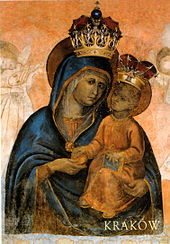Church of the Visitation of the Blessed Virgin Mary, Kraków
Church of the Visitation of the Blessed Virgin Mary (Polish: Kościół Nawiedzenia Najświętszej Maryi Panny) is a historic Roman Catholic church in Kraków, Poland; located at ul. Karmelicka 19 street in the Old Town.[1][2] It is the city's first Carmelite Church, hence the name of the street on which it stands.[3][4]



History
editAccording to legend, the earliest church on the same site was founded in the 11th century by Duke Władysław I Herman after a vision led him to this spot northwest of the city walls, where he found blooming violets in sand which cured him of a disfiguring case of scurvy. The sand gave the church its alternative name, the Carmelite Church in Piasek. However, the first attested church building was begun in 1395 on the initiative of Jadwiga of Poland and Władysław Jagiełło. On the outside wall of the church along Garbarska Street there's a stone with a footprint carved into it, allegedly set by the Queen herself.[5] The church was handed over in 1397 to the Carmelite Order recently invited by the Polish monarchs from Prague. The Gothic church was largely destroyed during the Swedish Deluge and was rebuilt in a Baroque style in the second half of the 17th century and consecrated in 1679.[2] On August 15, 1683, Jan III Sobieski said his final prayers in Kraków at this church before setting out for his victorious Battle of Vienna against the Ottoman Empire.[5][6] When the Confederacy of Bar seized control of the Old Town of Kraków in 1772, Russian troops used the church (just outside the Old Town walls) as an artillery sighting platform, leading to considerable damage. In 1997, Pope John Paul II raised the church to the status of a minor basilica.[2]
Architecture and interiors
editThe Baroque facade of the church is based on the design of Il Gesù in Rome. On the south-side wall of the church, at the corner of ul. Garbarska, there is the 18th century sculpture representing Golgotha with its central Crucificion. The main altar depicts the Visitation of Saint Elizabeth by Virgin Mary, and is one of the largest examples of Baroque woodcarving in Kraków. The most famous work of art in the church is the icon of Our Lady of Piasek, which can be found in a chapel on the south side of the nave.[4] According to legend, the icon is reputed to have been miraculously completed when left unfinished by its original artist in the 15th century. It survived unscathed even during the destruction of the majority of the walls around it by the Swedes. It was later fitted with a crown designed by the artist Jan Matejko, whose own wedding was held here in 1864.
Behind the church, now completely hidden from outside view by the surrounding buildings, there is still a surviving fragment of the old Carmelite orchard.[2]
-
Interior of the Basilica
-
The Golgotha Crucifixion
-
Swedish Deluge (fresco)
-
Altar of Bracka chapel
See also
editMedia related to Carmelite Church in Piasek, Kraków at Wikimedia Commons
References
edit- ^ "Rejestr zabytków nieruchomych - województwo małopolskie" [The Registry of Historic Buildings in Little Poland] (PDF) (in Polish). Krajowy Ośrodek Badań i Dokumentacji Zabytków. 2010. p. 45. Retrieved October 27, 2010.[permanent dead link]
- ^ a b c d "Historia Bazyliki (History of the Basilica at the Parish website)" (in Polish). Church of the Visitation of the Blessed Virgin Mary, Kraków. 2010. Archived from the original on January 23, 2012. Retrieved October 27, 2010.
- ^ "Museum in the Carmelite Church in Kraków". Arounder, VRWAY Communication. 2010. Retrieved October 28, 2010.
- ^ a b Marek Strzala (2010). "Sacred Paintings and Sculptures in Krakow Churches". Krakow Info. Retrieved October 28, 2010.
- ^ a b "Carmelite Church (Visitation of the Blessed Virgin Mary)". Krakowskie Biuro Festiwalowe. 2010. Archived from the original on July 20, 2011. Retrieved October 28, 2010.
- ^ "325 Rocznica Wiktorii Wiedenskiej (325 Anniversary of the Viena Victory)" (in Polish). Urząd Miasta Krakowa. 2008. Retrieved November 1, 2010.
Jan III Sobieski 15 sierpnia 1683 roku, przed wyprawą na Wiedeń, z żoną i synem modlił się przed cudownym wizerunkiem Matki Boskiej Piaskowej (oo. Karmelitów Na Piasku)
[permanent dead link]
Further reading
edit- Ryszard Burek (ed). Encyclopedia Krakowa (2000) pp. 461–462
- Michał Rożek, "Kościół OO. Karmelitów na Piasku w Krakowie" (1990)